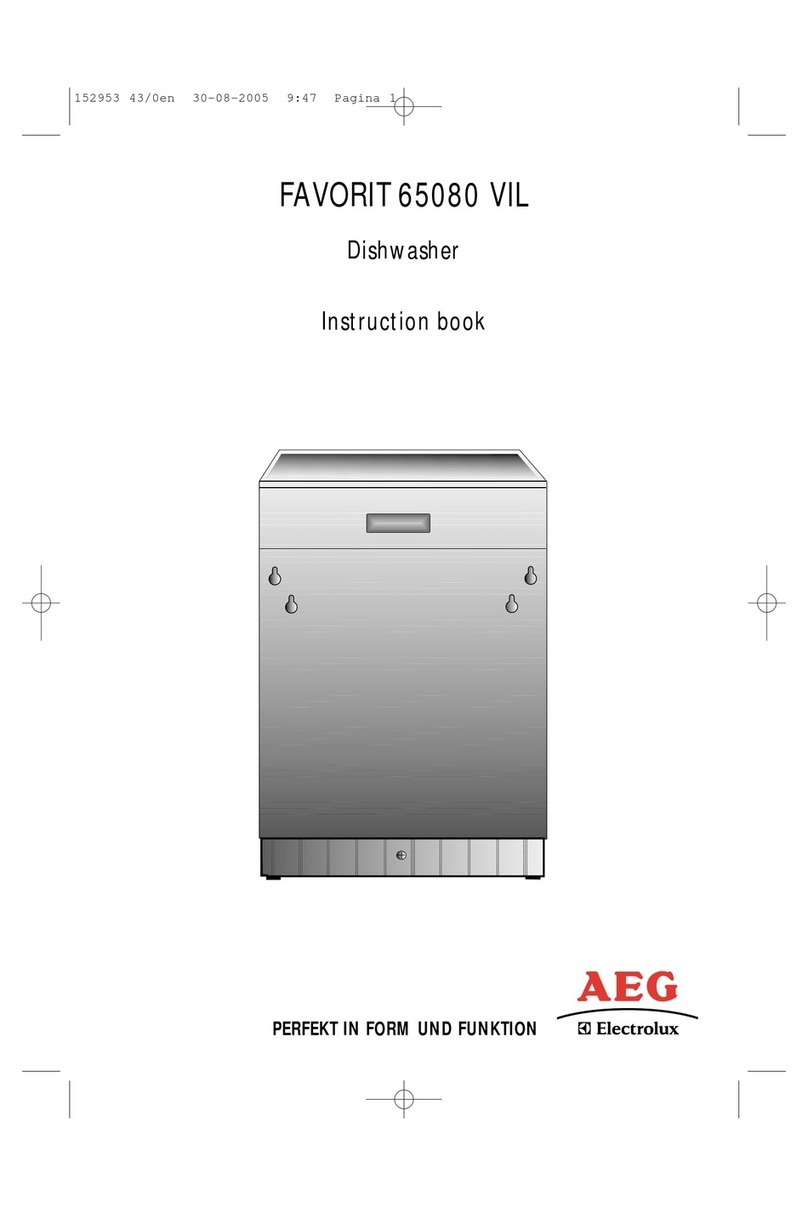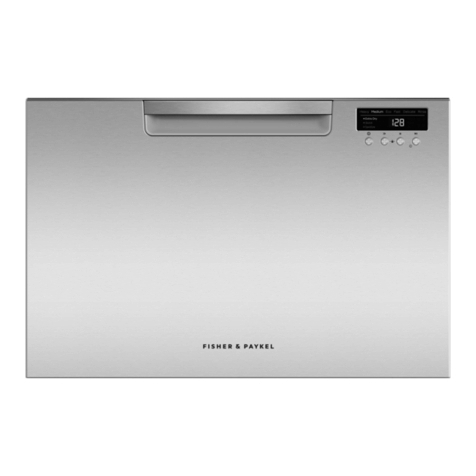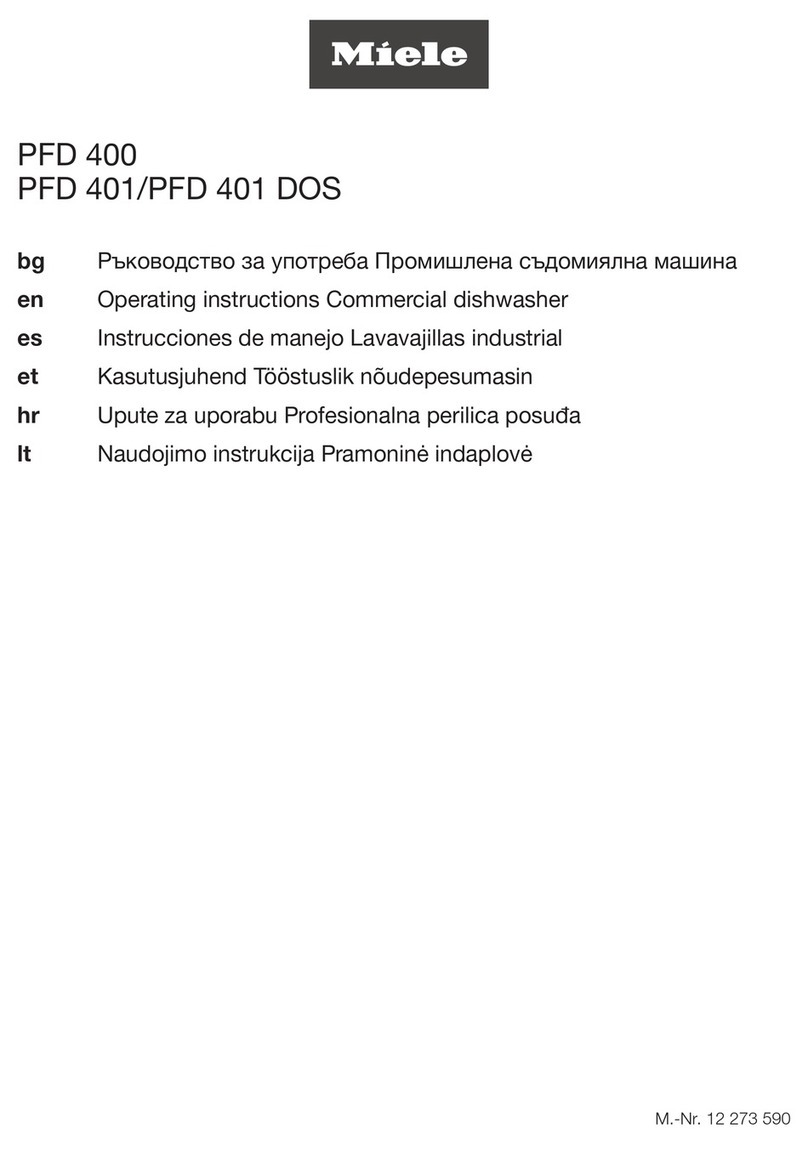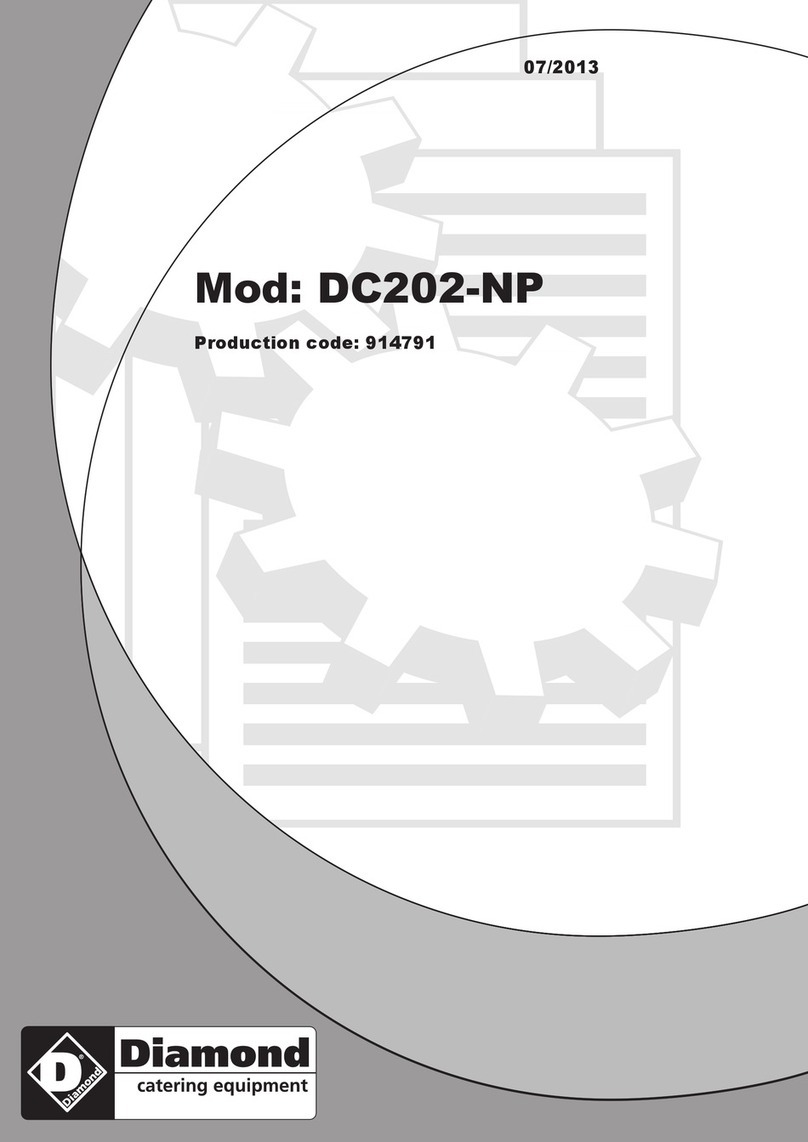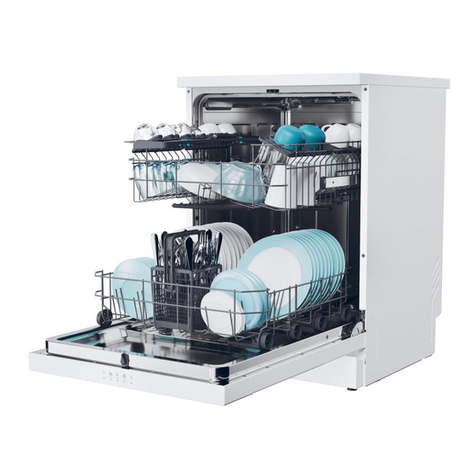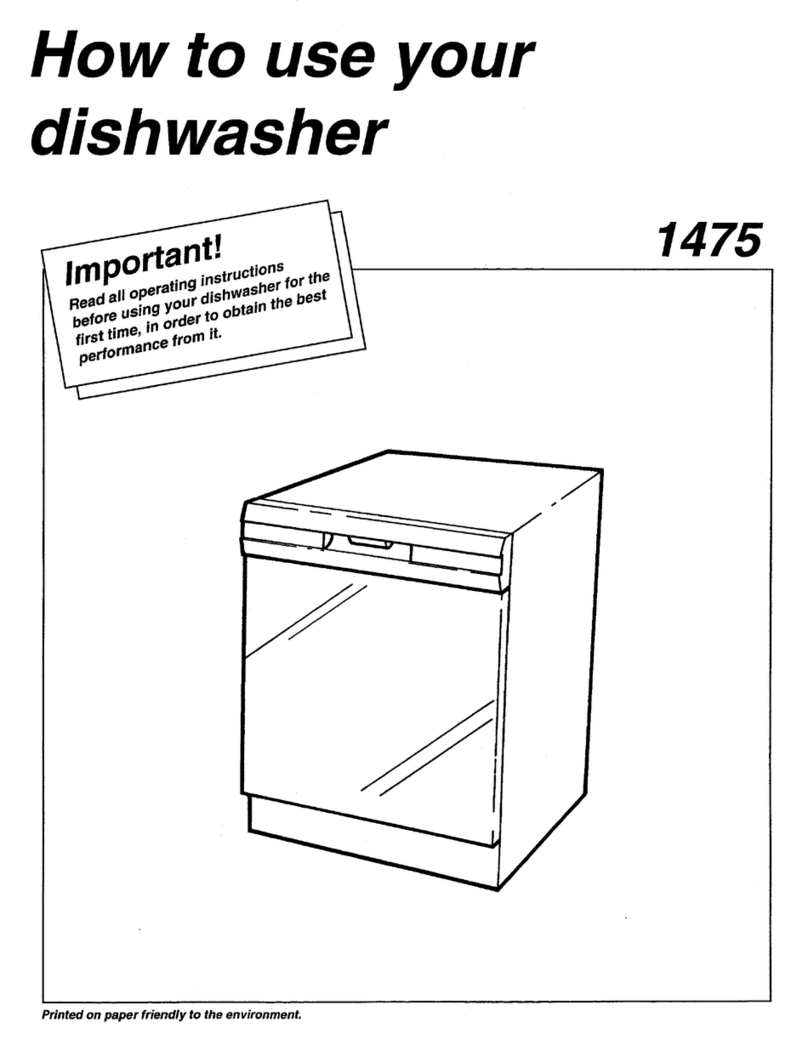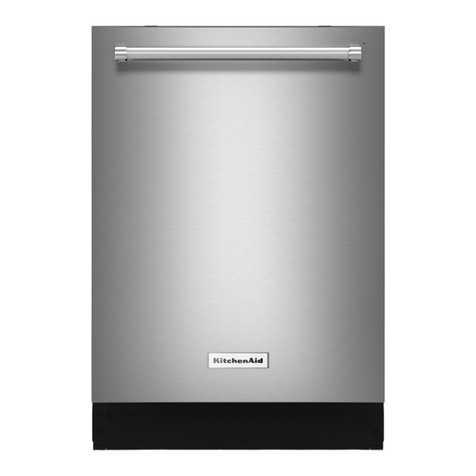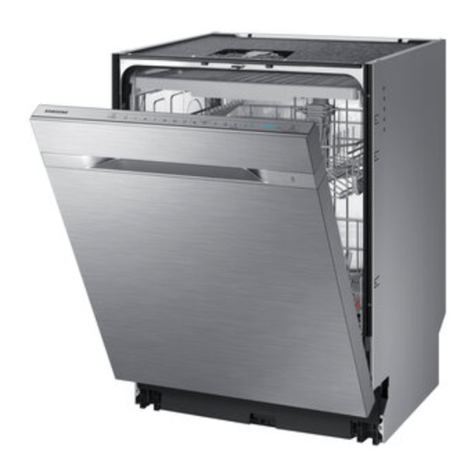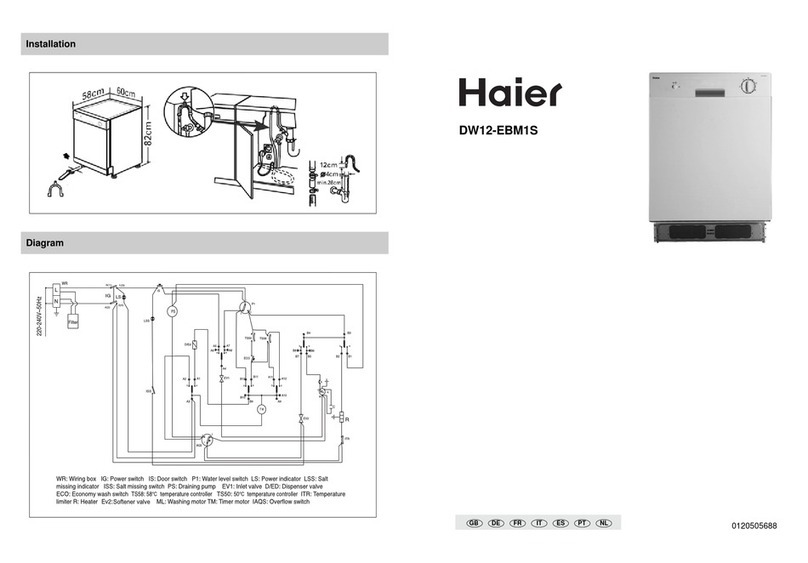Belling BEL IDW45 User manual

22
·ÖÇø
DD
[]
()
BEL IDW45(7712D)
(BELLING)
1 PANTONE BLACK C
2
3 A4, A5
4
105
6710020223

9 place settings
10 place se ttings
half-load function
Alt function
BEL IDW45

To review the sect ion on troubleshooting Tips
will help you to solve some common problems
by yourself .
Dear Customer,
Please carefully read this manual before using the
dishwasher, it will help you to use and maintain the
dishwasher properly.
Pass it on to any subsequent owner of the appliance.
This manual contains sections on safety Instructions,
Operating Instructions, Installation Instructions and
Troubleshooting Tips, etc.
The manufacturer, following a policy of constant
development and updating of the product , may
make modifications without giving prior notice.
Keep it as a refer in the later days.
If you can not solve the problems by yourself ,
please ask for the help of professional technicians.
Dishwasher Features.......... ... ......... ... ......... .. ...6
A Water S oftener..... ........ ......... ......... ..... ....... 7、
Attention before or after loading the Di shwasher
Baskets........................ .................... ............ 12
Filtering System.............................................16
Caring for the Dishwasher..................... .........17.
B Loadi ng the Salt into the Softener.................8、
C Fill the Rinse A id Dispenser................. ........8、
D Functio n of Detergent ............... ..................9、
Lo ading the uppe r .. ... ...... ... ...... .. . ...... ..13Ba ske t
Lo ading t he Low er ..... ...... ... ... ... ...... .....13Ba sket
Wash Cycle Table................................... ........14
Turning on th e Ap pliance ...... . .. ...... ... ... ...... ... .. 1 4
Change the Programme.............. ................15....
At the end of the Wash Cycle...........................15
Befor e calling for service.......................... . .....25.
Erro r co des.... ... ... ...... ... .. .... ... ...... . . ...... ... ... ..26.
Techn ica l in format ion.... ... ...... ...... ...... ..... .. ... 2 7..
Co ntrol Pan el. ... ... ......... ......... ... ... ... ......... .... .. ..6
.................................. 18Installation preparation
...19Aesthetic panel's dimensio ns and install ation
.... ..........21Tension adjustm ent of the door spring
.............................. 21Connection of drain hoses
......................... 22Dishwasher installation steps
Abo ut Electrici ty Con necting..... ... ... ... ... ... ... ....23
Co ld Wate r Con nect ion..... ... ... ...... .. ...... ... ...... 24

1
This appliance is intended to be used in household
and similar applications such as:
-staff kitchen areas in shops, offices and other
working environments;
-farm houses;
-by clients in hotels, motels and other residential type
environments;
-bed and breakfast type environments.
This appliance can be used by children aged from 8
years and above and persons with reduced physical,
sensory or mental capabilities or lack of experience
and knowledge if they have been given supervision
or instruction concerning use of the appliance in a
safe way and understand the hazards involved.
Children shall not play with the appliance. Cleaning
and user maintenance shall not be made by children
without supervision. For EN60335-1
This appliance is not intended for use by persons
(including children )with reduced physical, sensory
or mental capabilities, or lack of experience and
knowledge ,unless they have been given supervision
or instruction concerning use of the appliance by a
person responsible for their safety. For IEC60335-1
This appliance is for indoor use only, for household
use only.
To protect against the risk of electrical shock, do not
immerse the unit, cord or plug in water or other liquid.
Please unplug before cleaning and maintenance the
appliance .
Use a soft cloth moisten with mild soap, and then use
a dry cloth to wipe it again.
( )
( )
When using your dishwasher,
follow the precautions listed below:

2
This appliance must be earthed. In the event of a
malfunction or breakdown, earthing will reduce the risk
of anelectric shock by providing a path of least
resistance of electric current. This appliance is equipped
with a cord having an equipment-earthing conductor
and a grounding plug.
The plug must be plugged into an appropriate outlet that
is installed and earthed in accordance with all local
codes and ordinances.
Improper connection of the equipment-earthing
conductor can result in the risk of an electric shock.
Check with a qualified electrician or service
representative if you are in doubt whether the appliance
is properly grounded.
Do not modify the plug provided with the appliance;
If it does not fit the outlet.
Have a proper outlet installed by a qualified electrician.
Do not abuse, sit on, or stand on the door or dish rack of
the dishwasher.
Do not operate your dishwasher unless all enclosure
panels are properly in place.
Open the door very carefully if the dishwasher is
operating, there is a risk of water squirting out.
Do not place any heavy objects on or stand on the door
when it is open. The appliance could tip forward.
When loading items to be washed:
1) Locate sharp items so that they are not likely to
damage the door seal;

3
2) Warning: Knives and other utensils with sharp points
must be loaded in the basket with their points down or
placed in a horizontal position.
Check that the detergent powder is empty after
completion of the wash cycle.
Do not wash plastic items unless they are marked
dishwasher safe or the equivalent.
For plastic items not so marked, check the manufacturer's
recommendations.
Use only detergent and rinse additives designed for
an automatic dishwasher.
Never use soap, laundry detergent, or hand washing
detergent in your dishwasher.
Children should be supervised to ensure that they do not
play with the appliance.
The door should not be left open, since this could increase
the risk of tripping.
If the supply cord is damaged, it must be replaced by the
manufacturer or its service agent or a similarly qualified
person in order to avoid a hazard.
During installation, the power supply must not be
excessively or dangerously bent or flattened.
Do not tamper with controls.
The appliance is to be connected to the water mains using
new hose sets and that old hose-sets should not be reused.
The maximum number of place settings to be washed
is 10.
The maximum permissible inlet water pressure is 1MPa.
The minimum permissible inlet water pressure is 0.04MPa.

Dispose of the dishwasher packaging material
correctly.
All packaging materials can be recycled.
Plastic parts are marked with the standard
international abbreviations:
PE for polyethylene, e.g. sheet wrapping material
PS for polystyrene, e.g. padding material
POM polyoxymethylene, e.g. plastic clips
PP polypropylene, e.g. Salt filler
ABS Acrylonitrile Butadiene Styrene, e.g. Control
Panel .
Packaging material could be dangerous for children!
For disposing of package and the appliance please
go to a recycling centre. Therefore cut off the power
supply cable and make the door closing device
unusable.
Cardboard packaging is manufactured from recycled
paper and should be disposed in the waste paper
collection for recycling.
By ensuring this product is disposed of correctly, you
will help prevent potential negative consequences
for the environment and human health, which could
otherwise be caused by inappropriate waste handling
of this product.
For more detailed information about recycling of this
product, please contact your local city office and your
household waste disposal service.
DISPOSAL: Do not dispose this product as unsorted
municipal waste. Collection of such waste separately
for special treatment is necessary.
4

Compartment A:Compartment A:
With each wash cycle.
Compartment B:B:
For programmes with pre-wash only.
(Follow the user instructions!)
Mechanical indicator C.Mechanical indicator C.
Electric indicator on control panel (if provided).
Check the rinse aid level
(On models with water softener system only.)
Electric indicator on control panel (if provided).
If there is no salt warning light in the control panel
(for some models), you can estimate when to fill the salt into
the softener by the number of cycles the dishwasher has run.
Check the regeneration
salt level
Load the baskets
Select a programme
T urn on the water tap ,close the door . The machine will start working after about 10 seconds.
Running the dishwasher
Switch off the appliance
Turn off the water tap,
unload the baskets
Fill the detergent dispenser
Warning: wait a few minutes (about 15 minutes) before unloading the dishwasher to avoid handling
the dishes and utensils while they are still hot and more susceptible to break.
They will also dry better.Unload the appliance, starting from the lower basket.
Changing the programme
Add forgotten dishes in the
dishwasher.
Scrape off any large amount of leftover food. Soften remnants of burnt food in pans,
then load the baskets. Refer to the dishwasher loading instructions.
Press the Programme Button until the selected programme lights up.
( See the section entitled Operation instruction )
When the working cycle has finished, the buzzer of the
dishwasher will sound 8 times, then stop.
Turn off the appliance using the On/Off Button.
If the appliance is switched
off during a wash cycle.
Open the doorcarefully.
Hot steam mayescape
when the dooris opened!
WARNING!
If the appliance is switched off during a wash cycle, when switched
on again, please re-select the washing cycle and operate the dishwasher
according to the original Power-on state ).
Switch on the appliance
Open the door,press the On/Off button to switch on the appliance .
1.Open the door a little to stop the dishwasher.
2.After the spray arms stop working, you can open the door completely.
3.Add the forgotten dishes.
4.Close the door, the dishwasher will start running again after 10 seconds.
2.Quick operation guide2.Quick operation guide
For detailed operating method read the corresponding content on the instruction manual.
1. A running cycle can only be modified if it has been running for a short time. Otherwise the detergent
may have already been released and the water already drained. If this is the case, the detergent
dispenser must be refilled.
2. Open the door.
3. Press the Programme Button for more than 3 seconds to cancel the running programme.
4. Select a new programme.
5. Restart the dishwasher.
CC
AA
BB
5

6
before usin g it for the first time.
To get the best performance from your dishwashe r, read all operatin g instructions
1.On/Off Button: To turn on/off the power supply.
3.Program Button : To Press the button to select a
wash Program.
4.Delay Button : To Press the button to delay.
5. Display sc reen: to show the error code,delay time etc.
Delay time,Program indicators or error codes
indicator:
Half load functions indicator:
Infall Warning Light :
Being on When faucets is not opened.
Rinse Aid indicator:
Indicates when the dispenser needs to be refilled.
Add salt indicator:
Indicates when the dispenser needs to be refilled.
2.Half load functions Button: To select Half load
functions. (With this Half load function you can
only use it when you have only about or less than
6 place setting dish wave, and you will see less
water and energy consumption , can only be used
with Intensive, Normal, ECO, Glass and 90 min .)
P1 P2 P3
P4 P5 P6 P
1
2
3
4
5
7
611
Back View
8
Front view
Lower basket
Salt container
Dispenser
Cup shelf
Spray arms
Filter assembly
Inlet pipe connector
Drain pip eUpper basket
Cutlery rack
1
Inner pipe
5
6
7
8
9
10
11
3
2
4
910

The water softener must be set manually, using the water hardness dial.
The water softener is designed to remove minerals and salts from the water, which would have
a detrimental or adverse effect on the operation of the appliance.
The higher the content of these minerals and salts, the harder your water is.
The softener should be adjusted according to the hardness of the water in your area. Your local Water Authority
can advise you on the hardness of the water in your area.
Adjusting Salt Consumption
The dishwasher is designed to allow for adjustment in the amount of salt consumed based on the hardness of
the water used. This is intended to optimise and customise the level o f salt consumption.
1. Open the door ,Switch on the appliance;
2. Press the Program button for more than 5 seconds to start the water softener
set model within 60seconds after the appliance was switched on( The Salt and
Rinse aid warninglights will be on periodically when it get in the set model );
3. Press the Program button to select the proper set according to your local environment,
the sets will change in the following sequence: H4 H5 H6 H1 H2 H3;
4. Press the Power button to end the set up model.
→ → → → →
WATER SOFTENER
The hardness of the water varies from place to place. If hard water is used in the dishwasher, deposits will
form on the dishes and utensils.
The appliance is equipped with a special softener that uses a salt container specifically designed to eliminate
lime and minerals from the water.
Contact your local water board for information on the hardness of your water supply.
Please follow the steps below for adjustment in salt consumption.
7
If your model do es no t have an y wa ter soften er, y ou may sk ip th is se ction .
C lar k: Br itish de gr ee
fH : Fr ench de gr ee
D H: G er man degree
dH=1.25 Cla rk e=1. 78 f H=0.1 78mm ol/l
1
Th e ma nuf acto ry se tt ing: H3 (EN 50 242)
Before using your dishwasher for the first time:
A. Set the water softener
B. Add 1.5Kg dishwasher salt and then full fill the salt container with water
C. Fill the rinse aid dispenser
D. Fill in detergent
dH mmol /l
0~90~5 0~0.94 H1 0
10-20
6-11
1.0- 2.0 H2 9
21-30
12-17 2.1- 3.0
H3
12
H4 20
fH
0~6
7-14
15-21
Clarke
WATE R HAR DNES S
Sel ect or Po si ti on S alt c ons ump ti on
( gram /c ycl e)
18-22 31-40 22-28 3. 1-4.0
41-6023-34 4.1- 6. 0 H5 30
H6 60
29-42
35-55 61-98 43-69 6. 1-9.8

1. The salt co ntainer must only be refilled when the salt warning light in the control panel comes on.
Depending on how well the salt dissolves, the salt warning light may still be on even though the
salt container is filled.
If there is no salt warning light in the control panel (for some Models),you can estimate when to fill
the salt into the softener by the cycles that the dishwasher has run.
2. If there are spills of the salt, a soak or a rapid program should be run to remove the excessive salt.
Always use th e salt int ended f or u se with dis hwash er.
The salt con tai ner is loca ted be neath th e low er basket an d sho uld be fil led as exp laine d
in th e fo llowin g:
Attenti on!
Only use sa lt specific ally d esign ed for the u se in dishw ashe rs! Ev ery oth er t ype o f
salt n ot sp ecifically desi gne d for the use in a dishwa sher, es pecia lly ta ble salt, wi ll
damage the water so fte ner. In c ase o f da ma ges ca use d by t he u se of unsu itable
salt t he m anu facturer does no t give any wa rr anty no r is lia ble f or a ny d ama ges caus ed.
Only fill with s alt ju st be for e start ing o ne of th e com ple te wa shin g prog rams.
This will pr eve nt an y gr ains of salt or salt y wate r, which may have been spilled,
rem ain ing on th e bo ttom of the m achine for any p eriod o f tim e, wh ich m ay ca use
cor ro sion.
8
T he r inse a id is rel ea se d duri ng th e f inal r inse to prevent w ater fr om form ing dropl ets on yo ur di shes , whi ch can
leave spots and streaks. It also im proves dryi ng by all owing w ater t o r oll of f the dishes. Your dishwasher is
de signed to use liq ui d r inse a ids. The rins e ai d di spens er i s located i ns ide the door n ext t o t he d et erg ent dispe nser.
To fill t he dispenser, o pen t he cap and pour the rin se aid into the d isp enser until t he l ev el indi cator turns com plet ely
black. The vo lum e of t he rinse aid container is about 110ml.
Rinse Aid Dispenser
Function of Rinse Aid
Rin se ai d is automa tical ly adde d dur ing the l a st ri nse, e nsur ing t h orough ri nsi ng , and spot and str eak fr ee dr ying .
Attention!
Only use branded rinse ai d f or dishwasher. Never f il l the r inse ai d disp ens er with any other substances
( e.g . Di shw asher cl e ani ng a gent, l iqui d de ter gen t) . This w ou ld d am a ge the appl ian ce.
Ful l fill the s al t c on ta iner wit h wa te r,It i s n ormal fo r a s mall a mou nt o f wa ter t o come o ut o f t he
salt con ta iner.
AAfte r the lower b as ket ha s be en r emo ved , unscrew an d re mov e the cap fro m the sa lt co ntai ner.
BP lace the end of the fu nne l (su pplied) into the h ole an d int ro duc e ab out 1. 5k g of dish was her sa lt.
C
DA fter fill ing the container , sc re w th e ca p tight ly bac k clockw ise.
EThe salt w arni ng li ght will stop being a fter the salt containe r h as b een fille d wi th salt.
FImmedia tel y a fter fi ll in g t he sal t i nt o t he s al t c ont ainer, a wa sh in g pr og ra m s ho ul d be s tar te d
pro gr am Otherw ise the filter sy stem, pum p or o ther imp or tant parts of th e machine may be da mage d
by sal ty w ater. Thi s is out of warra nt y.
(We sug gest to u se a sho rt
) .

9
To open the dispenser, turn the cap to the "open" (left) arrow and lift it out.
Pour the rinse aid into the dispenser, being careful not to overfill.
Replace the cap by inserting it aligned with "open" arrow and turning it to the closed (right) arrow.
Adjusting Rinse Aid Dispenser
The rinse aid dispenser has six or four settings. Always start with the dispenser
set on "4". If spots and poor drying are a problem, increase the amount of rinse
aid dispensed by removing the dispenser lid and rotating the dial to "5". If the
dishes still are not drying properly or are show spots, adjust the dial to the next
higher lever until your dishes are spot-free. The recommended setting is "4".
(Factory value is "4".)
Increase the dose if there are drops of water or lime spots on the dishes after washing.
Reduce it if there are sticky whitish stains on your dishes or a bluish film on glassware or
knife blades.
112233
1
2
3
As the rinse aid diminishes, the size of the black dot
on the rinse aid level indicator changes, as illustrated below.
Full
3 / 4 ful l
1 / 2 ful l
1 / 4 full - Should refill to eliminate spotting
Empty
Adjust lever
(Rinse)
Adjust lever
(Rinse)
When to Refill the Rinse Aid Dispenser
If there isno rinse-aid warning light in the control panel, youcan estimate the amount from the colour
of the opticallevel indicator C located next tothe cap. When the rinse-aid container is full, the whole
indicator will bedark .As the rinse-aid diminishes, the size of the dark dotdecreases. You should neverlet
the rinse aidlevel fall 1 / 4 full.
during the next wash. Don't forget to replace the cap before you close dishwasher door.
Clean up any rinse aid spilled while during filling with an absorbent cloth to avoid excessive foaming
NOTE:NOTE:
NOTE:NOTE:
Detergents with its chemical ingredients are necessary to remove dirt, crush dirt and transport it out of the dishwasher.
Most of the commercial quality detergents are suitable for this purpose.
D. Function of DetergentD. Function of Detergent
MAXMAX
Proper Use of Detergent
Use only detergentspecifically made for the use in dishwashers. Keep yourdetergent fresh and dry.
Don't put powdereddetergent into the dispenser until you're ready to washdishes.
Attention!
C (Rinse-Aid indicator)C

10
Amount of Detergent to Use
Based on their chemical composition, detergents can be split in two basic types:
Detergent tablets of different brands dissolve at different speeds. For this reason some
detergent tablets cannot dissolve and develop their full cleaning power during short
programs. Therefore please use long programs when using detergent tablets, to
ensure the complete removal of detergent residuals.
The dispenser must be refilled before the start of each wash cycle following the instructions
provided in the wash cycle table . Your dishwasher uses less detergent and rinse aid than
Conventional dishwasher. Generally, only one tablespoon of detergent is needed for
a normal wash load. More heavily soiled items need more detergent. Always add the
detergent just before starting the dishwasher, otherwise it could get damp and will not
dissolve properly.
Concentrated Detergent
Detergent Tablets
Detergent Dispenser
conventional, alkaline detergents with caustic components
low alkaline concentrated detergents with natural enzymes
Normally new pulverised detergent is without phosphate. Thus the water softener function of
phosphate is not given. In this case we recommend to fill salt in the salt container even when
the hardness of water is only 6 dH. If detergents without phosphate are used in the case of hard water
often white spots appear on dishes and glasses. In this case please add more detergent to reach
better results. Detergents without chlorine do only bleach a little. Strong and coloured spots will not
be removed completely. In this case ple ase choose a program with a higher temperature.
°
Detergents
There are 3 sorts of detergents
1.With phosphate and with chlorine
2.With phospha te and w ithout ch lorine
3.Without phosphate and without chlorine
Always add the detergent just before starting each wash cycle.
Only use branded detergent aid for dishwasher.
If the lid is closed: press release button. The lid will spring open.
Deter gent tablet
Deter gent pow der
Dishwasher detergent is corrosive!
Take care to keep it out of reach of children.

Fill the detergentdispenser with detergent.
The marking indicates the dosing levels , as
illustrated on theright:
The place of main wash cycle detergent placed.
The place of pre-wash cycle detergent placed.
Please observe the manufacturers dosing and storage
Recommendations as stated on the detergent packaging.
Close the lid and press until it locks in place.
If the dishes are heavily soiled, place an additional
detergent dose inthe pre-wash detergent chamber. This detergent willtake effect during the pre-washphase.
A
B
Fill in Detergent
You find information about the amount of detergent for the single programme on the last page.
Please aware, thataccording to the level soiling andthe specific hardness of water differences are possible.
Please observe themanufacturer's recommendations on the detergent packaging.
NOTE:NOTE:
11
AABB

Cutlery with wooden, horn china or
mother-of-pearl handles
Plastic items that are not heat resistant
Older cutlery with glued parts that are not
temperature resistant
Bonded cutlery items or dishes
Pewter or cooper items
Crystal glass
Steel items subject to rusting
Wooden platters
Items made from synthetic fibres
Some types of glasses can become
dull after a large number of washes
Silver and aluminum parts have a
tendency to discolour during washing
Glazed patterns may fade if machine
washed frequently
Are not suitable Are of limited suitability
Dishes and items of cutlery must not lie inside one another, or cover each other.
To avoid damage to glasses, they must not touch.
Load la rge items which are most difficult to clean into the lower basket.
The upper basket is designed to hold more delicate and lig hter dishware such as glasses, coffee
and tea cups
Long bladed knive s stored in an upright position are a potential hazard!
Long and/or sharp items of cutlery such as carving knives must be positioned
horizontally in the upper basket.
Please do not overload your dishwasher. This is important for good results and for
reasonable consumption of energy.
Load hollow items such as cups, glasses, pans etc. With the opening facing downwards so that
water cannot collect in the container or a deep base.
Consider buying utensils which are identified as dishwasher-proof.
Use a mild detergent that is described as 'kind to dishes'. If necessary, seek further
information from the detergent manufacturers.
For particular items, select a program with as low a temperature as possible.
To prevent damage, do not take glass and cutlery out of the dishwasher immediately
after the programme has ended.
(For best performance of the dishwasher, follo w these loading guidelines.
Features and appearance of baskets and cutlery baskets may va ry from your model.)
Scrape off any large amounts of leftover food. Soften remnants of burnt food in pans.
It is not necessary to rinse the dishes under running water.
Place objects in the dishwasher in following way:
1.Items such as cups, glasses, pots/pans, etc. are faced downwards.
2.Curved items, or ones with recesses, should be loaded aslant so that water can run off.
3.All utensils are stacked securely and can not tip over.
4.All utensils are placed in the way that the spray arms can rotate freely during washing.
Very small items should not be washed in the dishwasher as they could easily fall out of the basket.
To prevent water dripping from the upper basket into the lower basket, we recommend that you
empty the lower basket first and then the upper basket.
12

13
The upper basket is designed to hold more delicate
and lighter dishware such as glasses, co ffee and
tea cups and saucers, as well as plates, sm all bowls
and shallow pans (as long as they are not too dirty).
Position the dishes and cookware so that they will
not get moved by the spray of water.
We suggest that you place large items and the most
difficult to clean items are to be placed into the lower
basket: such as pots, pans, lids, serving dishes and
bowls, as shown in the figure belo w. It is preferable to
place serving dishes and lids on the side of the racks
in order to avoid blocking the rotation of the top spray
arm.
Pots, serving bowls, etc, must always be pla ced top down.
Deep pots should be slanted to allow water to flow out.
Please be reminded that:
The Bottom Basket features folding spikes so that larger or more pots and pans can be loaded.
Fo lding Spikes of Lo wer Basket
For better stacking of pots and pans,
the spikes can be folded down as
show in the picture right.
Adjusting the Upper Basket
The height of the upper basket can be adjusted in order to
create more space for large utensils both for the upper
/lower basket. The height of the upper basket can be
adjusted by placing the wheels on different height of the
rails. Long items, serving cutlery, salad servers and knives
should be placed on the shelf so that they do not obstruct
the rotation of the spray arms..
Fo lding back the cup shelives
For better stacking of pots and pans,
the spikes can be folded down as
show in the picture right.
Cutlery should be placed in the cutle ry rack separately from each other in the appropriate positions, and do
make sure the utensils do not nest together, this may cause bad performance.
Do not let any item extend through the bottom.
Always load sharp utensils with the sharp
point down!

*EN 50242 : This programme is the test cycle. The information for comparability test
in accordance with EN 50242, as follows:
Capacity: 10 setting
Position Upper basket: upper wheels on rails
Rinse aid setting: 6
Pl:0.49w; Po:0.45w.
Starting a cycle wash
Draw out the lower and upper basket, load the dishes and push them back.
It is commended to load the lower basket first, then the upper one (see the section entitled
Loading the Dishwasher ).
Pour in the detergent (see the section entitled Salt, Detergent and Rinse Aid ).
Insert the plug into the socket. The power supply is 220-240 VAC /50 HZ, the specification
of the socket is 10A 250VAC. Make sure that the water supply is turned on to full pressure.
Open the door, press the ON/OFF Button, and the ON/OFF light will turn on.
Press the program Button , the wash program will be changed as follows direction:
If a program is selected, the response lig ht will light. Then close the door, the dishwasher
begin s to start.
“ ”
“ ”
P1->P2->P3->P4->P5->P6
;
1
2
3
4
5
Means: need to fill rinse into the Rinse-Aid Dispense r.
( )
14
For normally soiled loads,
such as , pla tes,glasses
and lightly soiled pans.
pots
Fo r he avie st s oiled cro ckery,
an d norm ally s oile d pots
pa ns dishes etc with dri ed
on soil ing.
、
、
For lightly soile d loads that
do not need excellent drying
efficiency.
A shorter wash for lightly
soiled loads and quick wash .
For lightly soiled crockery
and gl ass
(or )3in1
3/22g
(or )3in1
3/22g
(or )3in1
3/22g
Wash (45 )
Rinse
Rinse ( 55 )
℃
℃
17 5
19 0
16 5
30
1. 1
0.7 4
1.4
0.7
16.5
13
9
10
Wash(65 )
Rinse
Rinse (65 )
Drying
℃
℃
90 11.5
1.15
20g
3/22g
Pre -wash
was h(40 )
Rinse
Rinse (6 0 )
Dry ing
℃
℃
12 5
0. 75 13. 5
25g
Pre was h 5 0
Wash 60
Rinse
Rinse
Rinse 70
Dry ing
( ℃ )
( ℃ )
( ℃)
Pre was h(45 )
Wash (55 )
Rinse
Rinse ( 65 )
Dry ing
℃
℃
℃
Pre was h
Wash (45 )
Rinse (6 5 )
Dry ing
℃
℃
Th is is s tan da rd pr og ramm e, it i s
su ita ble to cl e an n orma lly soil ed
tab le wa re an d i t is th e m os t e ffic ient
program me in te rm s of its comb ined
en erg y and w at e r c on su mp ti o n for
tha t t yp e o f ta bl eware .
ECO
Int ensive
Normal
( *E N 50 24 2)
Rapid
90 Min
Gl as s
P1
P2
P3
P4
P5
P6
(Or3in1)
(Or3in1)

When the working cycle has finished, the buzzer of the dishwasher will sound for 8 seconds, then stop. Turn off
the appliance using the ON/OFF button, shut off the water supply and open the door of the dishwasher.
Wait for a few minutes before unloading the dishwasher to avoid handling the dishes and utensils while they
are still hot and more susceptible to breakage. They will also dry better.
Sw itch Off the D ishwa sher
The program light is on but is not blinking, only in this case the programme has ended.
Open the door.1. Switch off the dishwasher by pressing the ON/OFF button.
2.Turn off the water tap!
Op en the door carefu lly.
Hot dishes are sensitive to knocks. The dishes should therefore be allowed to cool down around 15 minutes
before removing from the appliance.
Open the dishwasher's door, leave it ajar and wait a few minutes before removing the dishes. In this way they
will be cooler and the drying will be improved.
Un loadin g the dishwasher
It is normal that the dishwasher is wet inside.
Empty the lower basket first and then the upper one. This will avoid water dripping from the upper Basket onto
the dishes in the lower one.
If you open the door , the machine will pause. The program light will
stop blinking and the buzzer will mooi ng every minute unless you close the door . After
you close the door ,the machine will k eep on working after 10 seconds.
during a wash cycle
Premise:
A cycle that is underway can only be m odified if it has only been running for a short time. Otherwise, the
detergent may have already been re leased, and the appliance may have already drain ed the wash water.
If this is the case, the detergent disp enser must be refilled (see the section entitled " L oading the
Detergent " ).
Open the door ,press the Program bu tton , the machine will be in standby state,
then you can change the program to t he desired cycle settin g (see the section entitled " Starting a
wash cycle. . ." ).
more than 3 seconds
1
2
A forgotten dish can be added any time before the detergent cup opens.
Add forgotten dishes.
Close the door
After the spray arms stop working, you can open the door
completely.
2
3
Open the door a little .
14
5The dishwasher will run after 10 seconds.
15
It is dangerous to open the door when washing,
because the hot water may scald you.

The filter prevents larger remnants of food or other objects from getting inside the pump.
The residues may block the filter, in this case they must be removed.
The filter system consists of a coarse filter,a flat (Main filter)
And a microfilter(Fine filter).
Food and soil particles trapped in this filter are pulverized by a
special jet on the lower spray arm and wash ed down to drain.
Larger items, such as pieces of bones or glass, that could block
the drain are trapped in the coarse filter. To remove the items
caught by the filter, gently squeeze the tap on the top of this
filter and lift out.
This filter holds soil and food residues in the sump area and
prevents it from being redeposit on the dishes during wash cycle.
Main filt er
1
Coarse filter
2
Fine filter
3
2
3
1
Filter assembly
The filter efficiently
For best performance and results, the filter must be cleaned regularly. this reason, it is a good idea to
remove the larger food particles trapped in the filter after each wash cycle by rinsing the semicircular filter and
cup under running water. To remove the filter device, pull the cup handle in the upward direction.
removes food particles from the wash water, allowing it to be recycled during the cycle.
For
The dishwasher must never be used without the filter s.
Improper replacement of the filter may reduce the per formance level of the appliance
and damage dishes and utensils.
Step 1 Turn the filter in anti-clockwise direction,:
Step 2 lift the filter a ssy up:
When following this procedure from step1 to step 2, the filter system will be removed;
when following it from Step 2 to Step 1, the filter system will be installed.
16
1
2

The control panel can be cleaned by using a lightly dampened cloth.
After cleaning, make sure to dry it thoroughly.
For the exterior, use a good appliance polish wax.
Never use sharp objects, scouring pads or harsh cleaners on any part of the dish washer.
Protect Against Freezing
1.Cut off the electrical power to the dishwasher.
2.Turn off the water supply and disconnect the water inlet pipe from the water valve.
3.Drain the water from the inlet pipe and water valve. (Use a pan to gather the water)
4.Reconnect the water inlet pipe to the water valve.
5.Remove the filter at the bottom of the tub and use a sponge to soak up water in the sump.
please take frost protection measures on the dishwasher in winter. Every fter washing cycles,
please operate as follows
time a
:
Cleaning the Filter
Cleaning The Door
To clean the coarse filter and the fine filter, use a cleaning brush. Reassemble the filter parts as shown in the figures
on the last page and reinsert the entire assembly in the dish washer, positioning it in its seat and pressing downwards.
When cleaning the filt ers, don't knock on them. Otherw ise, the filters could be
contorted and the per formanc e of the d ishwash er co uld be decr eased.
To clean the edge around the door, you should use only a soft warm, damp cloth.
To avoid penetration of water into the door lock and electrical components, do not
use a spray cleaner of any kind.
Never use a spray cleaner to clean the door panel as it may damage the door lock
and electrical components.
Abrasive agents or some paper towels should not be used because of the risk of
scratching or leaving spots on the stainless steel surface.
Cleaning the Spray Arms
If your dishwa sher cann ot wo rk becaus e of the ice,
p lea se co nt ac t p rof es sio na l s er vic e p erso ns .
It is necessary to clean the spray arms regularly for hard
water chemicals will clo g the spray arm jets and bearings.
- Inspect the filters for blocking after every time the dishwasher has been used.
- By unscrewing the coarse filter, you can remove the filter system. Remove any food remnants and
clean the filters under running water.
Remarks:
The entire filter assembly should be cle aned once a week.
To remove the lower spray arm, pull out the spray arm upward.
To remove the upper spray arm, hold the nut, rotate the arm
clockwise to remove it.
Wash the arms in soapy and warm water and use a soft brush to
clean the jets. Replace them after rinsing them thoroughly.
17
This manual suits for next models
1
Table of contents
Other Belling Dishwasher manuals

Belling
Belling BDW60IC User manual

Belling
Belling BDW60WTE User manual

Belling
Belling IDW604MK2 User manual
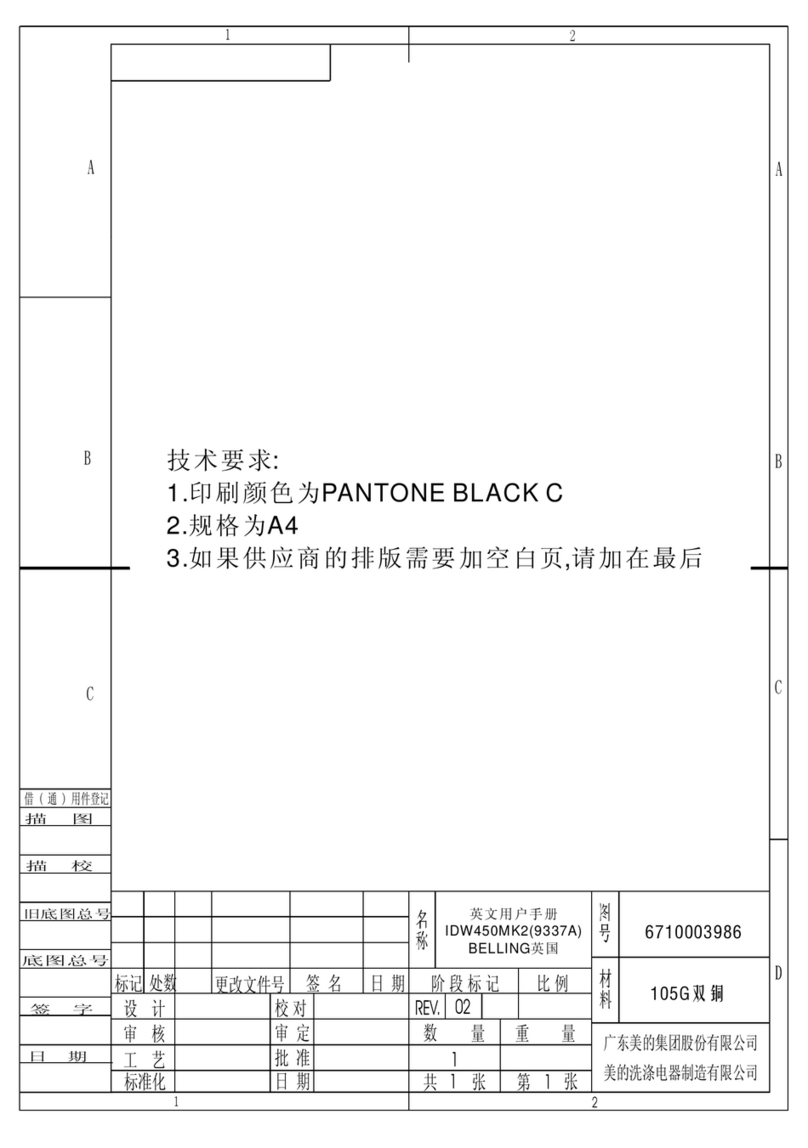
Belling
Belling IDW450MK2 User manual

Belling
Belling bdw60ss User manual
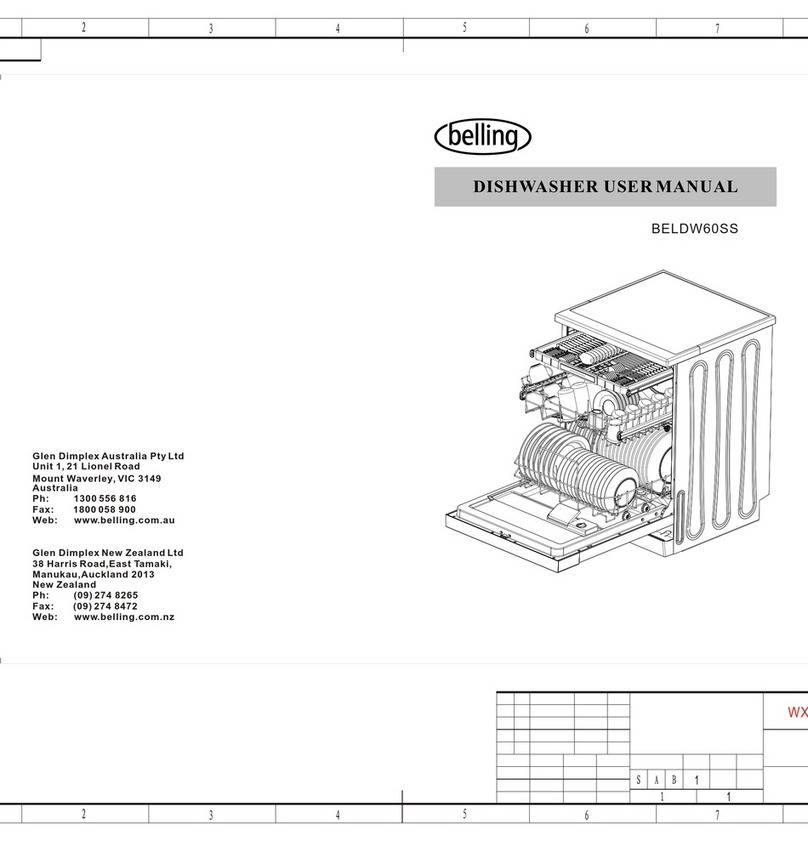
Belling
Belling BELDW60SS User manual
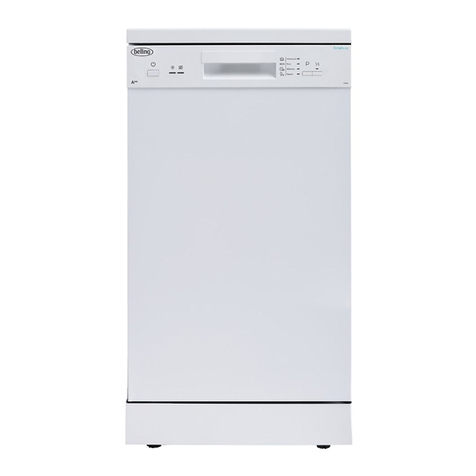
Belling
Belling BEL FDW90 WHI User manual
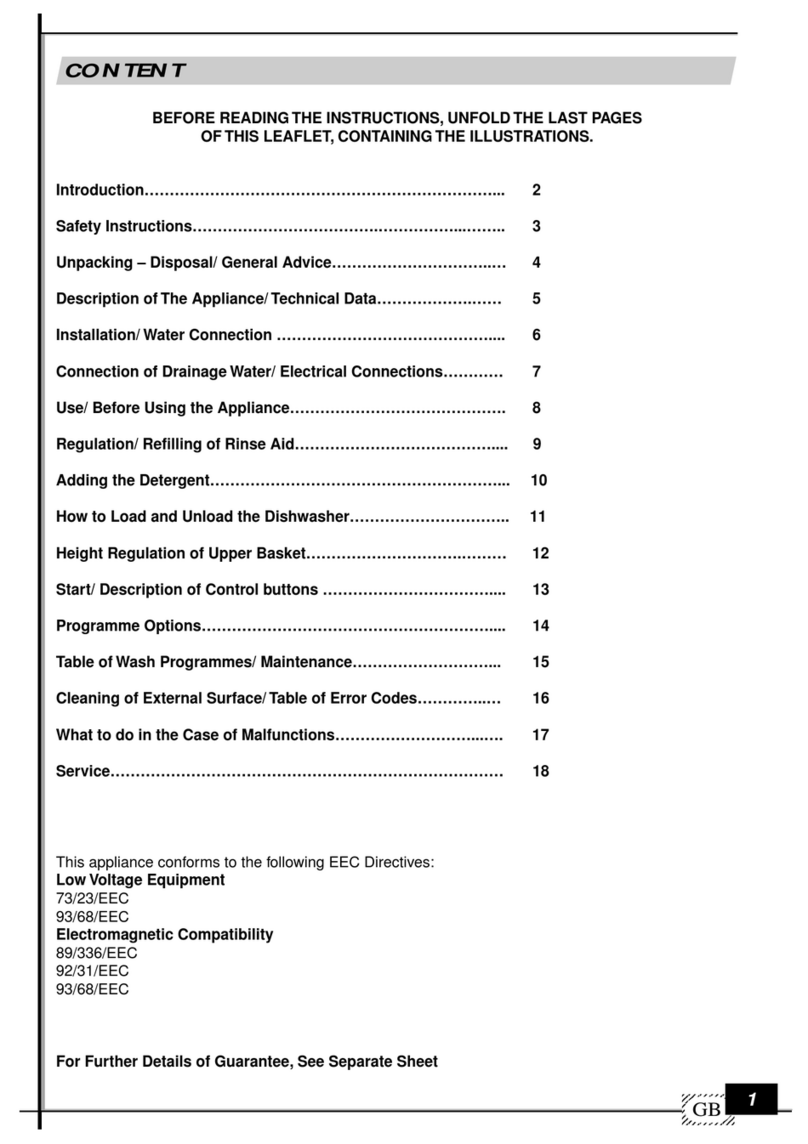
Belling
Belling IDW603 Instruction manual
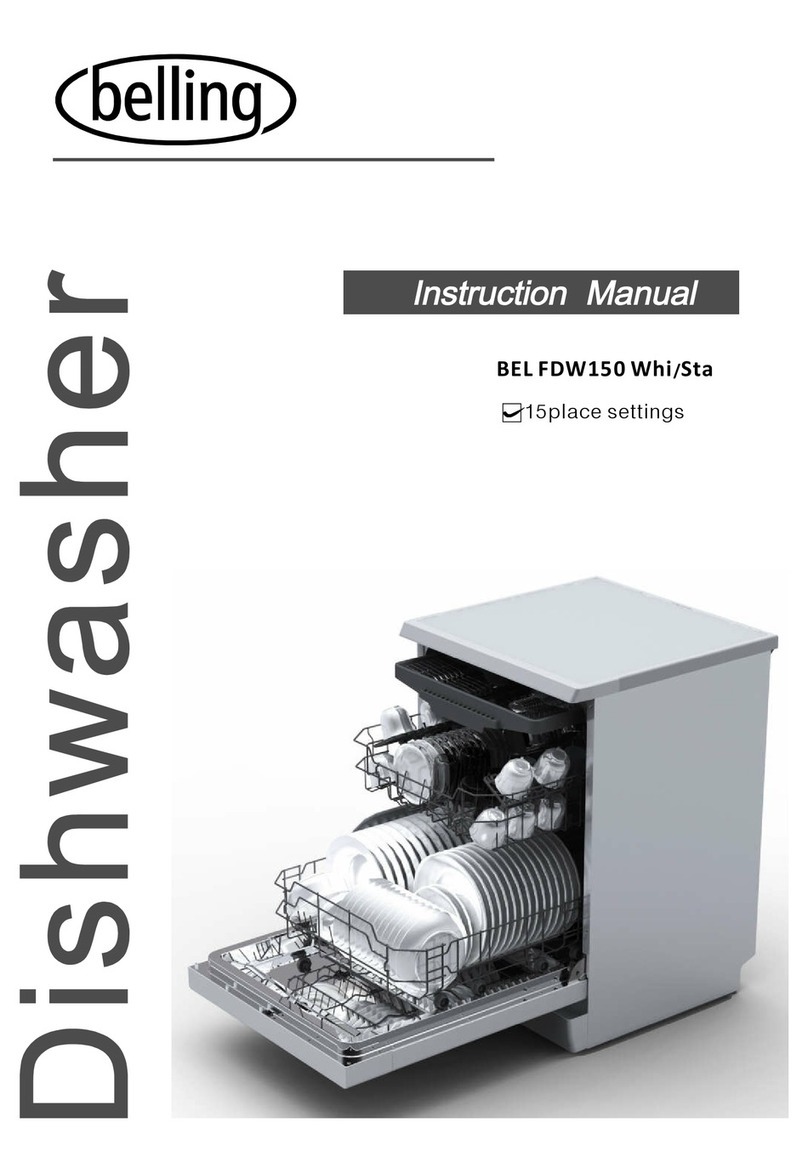
Belling
Belling BEL FDW150 Whi Sta User manual
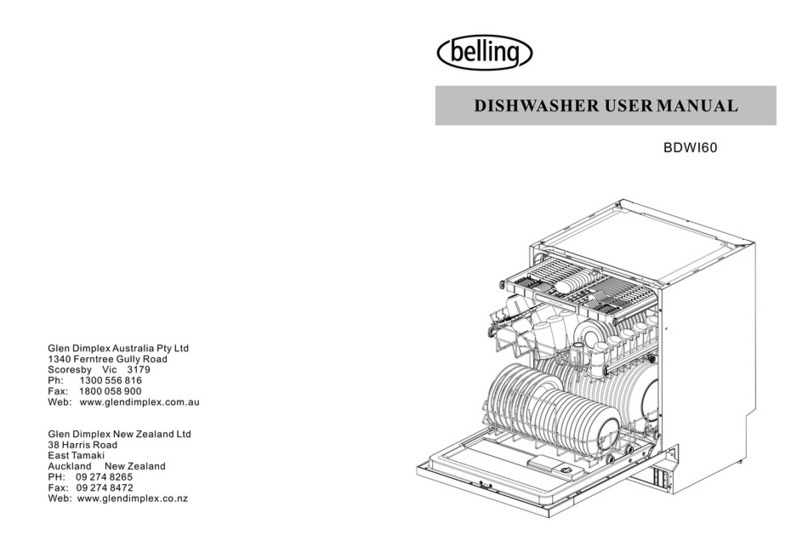
Belling
Belling BDWI60 User manual

